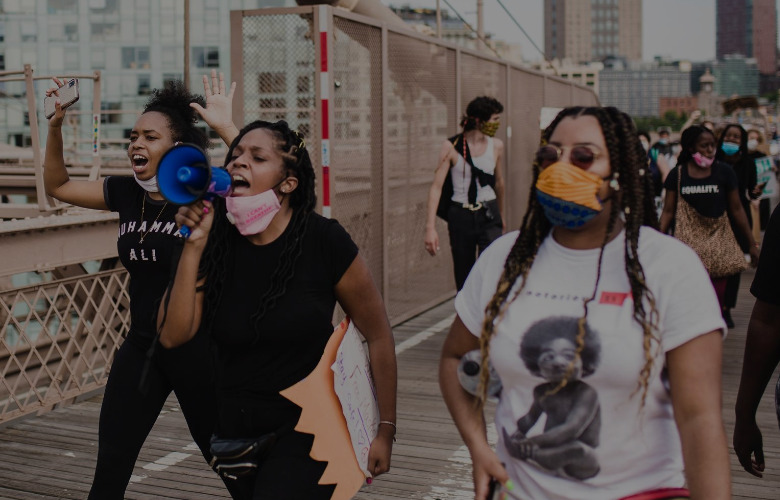
The flawed idea of a homogeneous European identity minimises the significant role that diversity has played in building Europe’s rich tapestry of ideas, arts and culture and excludes a large percentage of the members of our civilisation. Brexit, the murder of George Floyd and COVID-19 have all highlighted the impact of our disconnected and unequal society. All identities are complex, but it is that complexity that unites us and links us all together.
Representation is a key step towards equality. People telling their own stories in their own voices. Though this seems like an obvious step it is a vital one. Simply; you won’t change what you don’t understand, and you can’t understand what you don’t see. The ability to imagine a world that is different than the world we live in now is the beginning of affecting meaningful change. Art has the power to bring that imagination to life and amplify the voices of those unheard, connecting people and challenging the limiting narratives of national or European identity.
Spaces and opportunities where you can unapologetically express your individuality are rare. The voices of the marginalised are often distorted to fit a narrative of helplessness and dependency, reinforcing a culture of infantilisation of people who do not fit the euro-centric idea of success. As an artist you are typecast, tied to checking boxes and fitting specific narratives. The work you do is edited, cut and filtered through the perception of others. We use stories to navigate our way through life, they help us make decisions and shape the meaning of everything we do. So why do we keep presenting false and simplistic story lines that maintain stereotypes and strengthen unconscious discriminatory views?
Women, POC, the LGBT+ community and people with disabilities all live in that same society that perpetuates ungrounded biases resulting in low self-esteem and misleading views on their own identity. White supremacy tells us that black people do not matter. Patriarchy tells us women are less than. The stories we hear and tell ourselves strongly influence our actions. If you are consistently told that you do not fit in, belong or matter your only option for self-determination is to defy the structures and institutions that devalue your life daily, until they crumble.
The AVI Racial Narratives Project researched and tested the effect of narrative on public perception. They showed fictional footage of an arrest of a young black man merely trying to get into his own car. They showed the exact same footage to two groups of people, each with different commentary:
Group 1: A conservative commentary emphasising stereotypes
Group 2: An emphatic commentary humanising both officer and victim
83% of the people that watched the footage with an emphatic commentary believed the officer acted improperly, when only 62% of the people watching the footage with a conservative commentary believed the officer had no reason for arrest. By just changing the words that accompany the footage there was a 21% difference in public perception of the same event.
The unfiltered footage of the murder of George Floyd is a testament to the power of unbiased and uncensored storytelling. The flood of paintings, songs, poetry and street art that followed the event brought volume to the voices of black people, inspiring millions worldwide to not only question the issue of police brutality against black communities, but to proactively embrace anti-racism and the dismantling of the institutional and interpersonal structures that created such inequality in the first place.
Technology allows people to share experiences and connect emotionally to something or someone that is a million miles away. The broadcasting of the 1965 march to Selma was Dr. Martin Luther King’s way of getting people to see the daily struggles of the black community in America with their own eyes. He knew that you cannot understand what you do not see.
But more often than not, when we share accounts of marginalised communities, rather than uplifting and supporting change that is already taking place, we perpetuate the story of poor, helpless people in dire need of sympathy and help from white saviours. Our unconscious bias distorts the stories we tell when they are not our own. We have fixed ideas and set perceptions, fed by years and years of indoctrinated idealism, unable to fathom a different reality than the one we are taught. Our flawed educational system and the media failing to tell stories of POC, women, people with a disability and the members of the LGBT+ community in their own voices have created a culture that is founded on inequality and exclusion. Our social structures place traditional white and male qualities as central, making everything else subordinate. Whenever these structures are challenged the response is not to listen, but to increase control over oppressed groups: “All Lives Matter” being a perfect example. Maintaining domination through patriarchy, white supremacy and all that other fun stuff is for most people not an explicit effort, it is an old and defective system that we are born into and are unconsciously preserving.
Nietzsche’s concept of the “ubermensch” was hijacked by Hitler to mean the “superior Aryan race”. Though we all (well most of us) agree this is a despicable ideology, the notion of straight, white men being the “ubermensch”, is visible in nearly every aspect of today’s society. It’s more subtle perhaps, hidden in micro-aggressions, but very much alive.
We need to celebrate unsung heroes and reshape the flawed ideal of success. A limited notion of identity excludes all of us in different ways. Many people don’t feel like they have a national identity, by using art to amplify their voices we can create a global sense of identity that does not exclude people on the notion of being different. The idea of ‘being different’ implies that there is a normal. There is not.
We need to remove the pedestals on which we have placed patriarchy and white supremacy. We need to stop repeating hero mythologies of white men and stop erasing their flawed pasts in our history books. Founding father Thomas Jefferson owned more than 600 slaves in his adult life, King of Rock n Roll Elvis Presley dated 14 year old children, Nobel Prize winner James Watson wanted to use his celebrated DNA research to “die out swarms of black, brown, dirty-white and yellow people”, war hero Winston Churchill diverted food away from India to feed Europeans which lead to the death of 3 million Indians, renowned children’s author Roald Dahl was antisemitic and often said things like “Hitler didn’t pick the Jews for nothing”, and award winning singer Frank Sinatra routinely abused his wife and threatened her with a gun. Let’s tell it how it is. But what do we do if someone we do like does not tick the straight white man box? We simply change the narrative. Last time I checked Jesus was from the Middle East?
We must create a new normal for representing our society by creating spaces and opportunities for democratised stories and helping people to use their art to affect social change. A new standard for storytelling that is not tied to fitting a narrative, perpetuating stereotypes, checking boxes or hitting funding targets but tells stories that stay true to its protagonists.
Cuts, Closures and Consequences: Dance to Combat Crime


Maren is a creative and driven producer with a proven track record of designing, developing and delivering innovative and high-quality dance and arts projects. She is dedicated to developing strong leaders, creating opportunities and making the arts accessible to all. As an activist for social change, Maren keeps inclusion at the forefront of all her work.
Read Full Profile© 2021 TheatreArtLife. All rights reserved.

Thank you so much for reading, but you have now reached your free article limit for this month.
Our contributors are currently writing more articles for you to enjoy.
To keep reading, all you have to do is become a subscriber and then you can read unlimited articles anytime.
Your investment will help us continue to ignite connections across the globe in live entertainment and build this community for industry professionals.